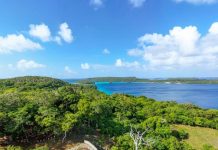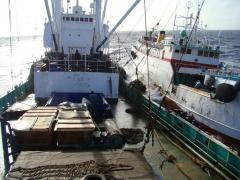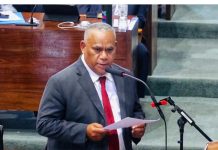Tuna fishing in the region
Tuna is extremely valuable to Pacific Island countries. In recent years, the annual catch of tuna in the western and central Pacific Ocean has been approximately 2.6 million metric tonnes per year, worth almost US$5 billion. This catch represents over 50 percent of all the tuna landings in the world. Surprisingly, the amount of tuna captured caught in the Pacific Island region is over ten times the amount of fish from all the other types of fishing in the region combined.
Although tuna is captured by a variety of fishing techniques, the vast majority is taken by industrial-scale operations using either purse seine or longline gear.
Tuna transshipment
Transshipment is a legitimate practice in the tuna fishing industry. In a typical transshipment operation, a refrigerated carrier vessel collects catch from multiple fishing boats and carries it back to port. This practice enables fishing vessels to continue fishing, which reduces fuel costs for fishing vessels and gets the catch to port quicker.
There are two main types of tuna transshipment in this region. In one type of operation the transshipment occurs in or near a port, normally under the authorisation, control, and inspection of the country where the port is located. In most Pacific Island countries the staff of the fisheries department monitor the volumes and species composition of the catch being transferred.
The other form of transshipment in the region (which is far more problematic) is transshipment at sea, particularly in the high seas – which are ocean areas beyond the exclusive economic zone of any country. In those areas the authorisation and controls over the transshipment are the responsibility of the country of registration of the concerned carrier vessel and fishing vessel. This type of transshipment is particularly common for longline vessels.
Problems with tuna transshipment
It is generally known that the volumes and composition of the catch being transferred in high seas transshipment is not as rigorously monitored as that for in-port transshipment.
High seas transshipment at sea is widely recognised as one of the main ways that illegally caught fish finds its way to market. Poorly monitored high seas transshipments offer opportunities to hide both illegal catches and prohibited fishing activities. The Food and Agriculture Organisation of the United Nations has stated that in the absence of effective monitoring and control, transshipping poses a serious risk to fisheries by allowing the catching and landing of fish to go unregulated and unreported. Within the western and central Pacific Ocean, it has been estimated by a recent study that US$142 million per year of tuna and tuna-like products are involved in illegal, at-sea transshipment.
The Western and Central Pacific Fisheries Commission
Tuna fishing in the central and western Pacific Ocean is regulated by both the countries in the region and the Western and Central Pacific Fisheries Commission (WCPFC). The Commission has a total of 42 member countries (including all independent Pacific Island countries), participating territories, and cooperating non-members. The WCPFC seeks to ensure, through effective management, the long-term conservation and sustainable use of highly migratory fish stocks (i.e. tunas and billfish) in the western and central Pacific Ocean.
The Commission develops conservation and management measures that are binding on vessels that fish in the region. These are enforced in various ways, including by on-board observers, electronic vessel monitoring systems, at-sea boarding and inspection, and aerial surveillance.
The WCPFC has a role in regulating transshipment. Recognising that transshipment on the high seas could cause problems, the international agreement that established the WCPFC states: “In order to support efforts to ensure accurate reporting of catches, the members of the Commission shall encourage their fishing vessels, to the extent practicable, to conduct transshipment in port.” Recognising this point, the Commission made a rule in 2009 stipulating there shall be no transshipment on the high seas except where a member country has determined that it is impractical for a vessel – but the Commission did not define “impractical”, thereby creating a loophole.
The current situation in the central and western Pacific
Contrary to the Commission’s intentions and rules, the number of high seas transshipments in the western and Central Pacific is actually increasing. Reports to the Commission indicate that such transshipments have increased from 544 operations in 2014 to 1,472 in 2019.
It appears that high seas transshipments are becoming the norm, rather than the exception. This situation is not conducive to the long-term conservation and sustainable use of tuna resources in the region – a stated aim of the Commission.
The way ahead
Recognising that poorly monitored high seas transshipments are a major factor in illegal tuna fishing in the region, there is a strong case for reforming such operations. There appear to be two possibilities for this:
•Ban transshipment on the high seas and require any transshipment to take place in a port where it can be easily monitored; or
•Greatly improve the monitoring of high seas transshipment.
The first possibility would certainly result in improved accountability and transparency of the tuna catches – but it would place additional costs on fishing vessels, such as extra distances to travel and port charges. This possibility would likely be opposed by the transshipping vessels and their countries of registration.
The second possibility for reforming high seas transshipment would be to have the observers onboard the carrier vessels produce detailed reports and have those reports sent in a timely manner directly to the Commission for analysis. This possibility is likely to be less of a burden on vessel operators – and hopefully would meet less opposition than simply banning high seas transshipment and forcing a major change in way vessels operate.
What can the governments of Pacific Island countries do to promote the reform of high seas tuna transshipment? Through their voice in the Western and Central Pacific Fisheries Commission, they should point out that poorly monitored high seas transshipment could threaten the benefits they receive from their tuna resources – and insist on closing this loophole that gives opportunities for illegal fishing.
SOURCE: PACNEWS














